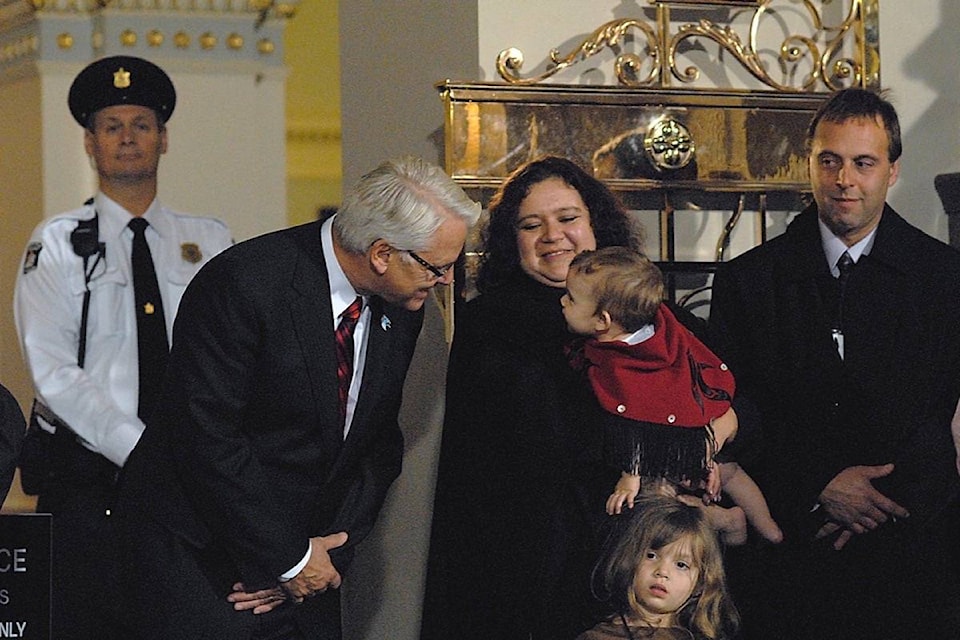Former Tsawwassen First Nation chief Kim Baird wasn’t born when the causeway and artificial island for B.C.’s biggest ferry terminal started construction in the late 1950s, but the story of its impact on the marine environment and traditional fishing village life remains vivid today.
“The way our elders tell it, the guy constructing the causeway knocked on the chief’s door,” Baird said at a forum on the province’s new Indigenous rights law at the recent B.C. Natural Resources Forum. “That’s how we found out, because the land had been expropriated through the Indian Agent.”
Baird described the impact of the ferry terminal and the adjacent Deltaport coal and container terminal in a 2007 speech to the B.C. legislature, when she led the Tsawwassen First Nation in the signing of the first modern-day treaty.
“Today we have a tiny postage stamp of a reserve, a small fraction of a percentage of our traditional territory fronting a dead body of water, trapped between two massive industrial operations,” she said. “The ferry causeway, with its millions of cars and trucks, dissects our reserve to the south. And Deltaport, with its 24/7 coal and container traffic, coats our houses with diesel particulate. Trucks and trains keep us awake at night.”
With its treaty’s substantial land and cash settlement, the Tsawwassen First Nation has developed Tsawwassen Mills shopping mall and further rail business to add to the water slide and other enterprises it has built to create employment. Now a consultant on Indigenous projects, Baird says there have been many successful agreements in B.C. that respect Indigenous land and treaty rights, without changing legislation to require it.
“The government has now made it provincial law that resource projects require our consent to move forward,” Cheslatta chief said at @BCNRF #bcpoli #cdnpoli #LNG pic.twitter.com/5m3QdxJp23
— Tom Fletcher (@tomfletcherbc) February 18, 2021
Also speaking to the forum by video conference Jan. 27, Chief Corrina Leween of the Cheslatta Carrier Nation didn’t detail the disruption caused by another 1950s project, construction of the Kenney Dam. Alcan dammed the Nechako River to power its aluminum smelter at Kitimat, and the flooding displaced the Cheslatta people to 17 small reserves around Francois Lake, south of Burns Lake.
But Leween was clear that the NDP government’s changes to environmental assessment give Indigenous people the first call on a project, and it’s up to Canada and B.C. to meet the terms of the UN Declaration on the Rights of Indigenous People (UNDRIP). B.C. is the first North American jurisdiction to legislate its principle of “free, prior and informed consent” for pipelines, mines, dams and other development.
“The government has now made it provincial law that resource projects require our consent to move forward,” Leween said. “If our nations don’t have the capacity to conduct our own due diligence, to retain our own lawyers and advisors, to provide our own environmental assessment, and to meaningfully consult with our members, then we are not able to provide an informed consent.”
Kevin O’Callaghan, an Indigenous specialist with Vancouver law firm Fasken, told the forum there are two legal camps on the effect of imposing UNDRIP on Canadian and B.C. law. “Either it means that governments must consult with a goal of obtaining consent, but can proceed without consent, or that governments must obtain consent,” O’Callaghan said.
Murray Rankin, a law professor, former MP and B.C.’s new minister of Indigenous relations, was not available for an interview. His office issued a statement confirming that the Environment Assessment Act changes introduced more than two years ago were to conform with UNDRIP by seeking Indigenous consent at two points when project proponents apply for permits.
“The first is early in the process at the readiness decision phase if the recommendation from the chief executive assessment officer or minister is to exempt or terminate the project from the environmental assessment process,” the ministry said. “The second point is near the end of the process on whether or not a project should receive an environmental assessment certificate.”
A ministry fact sheet states: “Ministers must take these decisions into consideration, but retain final decision-making. They must provide reasons if their decision does not align with the decision of participating Indigenous nations.”
The changes to B.C.’s environmental assessment process “turn it on its head,” Environment Minister George Heyman told reporters when the amendments were tabled in the B.C. legislature in November 2018. “Get those issues surfaced early and move ahead so that good, sustainable projects will get to the finish line so British Columbia communities can benefit, as can Indigenous peoples, from good jobs that are sustainable with respect to the environment.”
2018: B.C. government overhauls environmental assessment
2016: Tsawwassen Mills mall starts hiring for 3,000 positions
One of the problems still unsolved for Heyman, Rankin and four other cabinet ministers involved with resource development, is what to do when affected Indigenous communities disagree on a project. They may also disagree on whose territory is affected when land claims overlap without treaties, as they do in much of B.C.
B.C. and Ottawa still face a dispute in Wet’suwet’en territory over the Coastal Gaslink pipeline, which is supported by all elected Wet’suwet’en councils and the federal and provincial governments, but opposed by a small group of hereditary chiefs.
Premier John Horgan has stated repeatedly that the Wet’suwet’en people have to determine their own official position, as LNG Canada and its pipeline, the largest private sector investment in Canadian history, continues to be built across northern B.C.
@tomfletcherbc
tfletcher@blackpress.ca
Like us on Facebook and follow us on Twitter.
